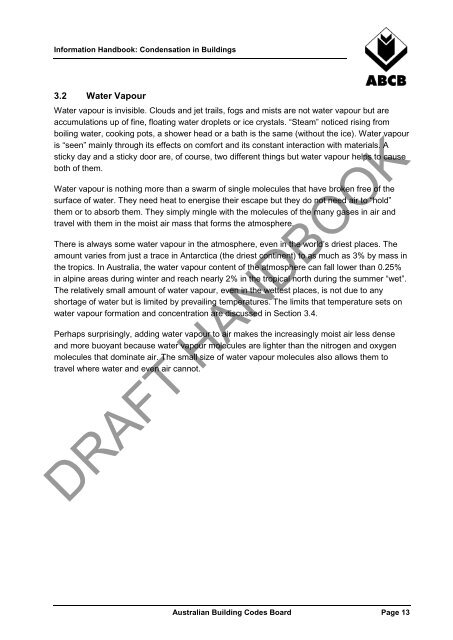Condensation in Buildings - Australian Building Codes Board
Condensation in Buildings - Australian Building Codes Board
Condensation in Buildings - Australian Building Codes Board
You also want an ePaper? Increase the reach of your titles
YUMPU automatically turns print PDFs into web optimized ePapers that Google loves.
Information Handbook: <strong>Condensation</strong> <strong>in</strong> Build<strong>in</strong>gs<br />
3.2 Water Vapour<br />
Water vapour is <strong>in</strong>visible. Clouds and jet trails, fogs and mists are not water vapour but are<br />
accumulations up of f<strong>in</strong>e, float<strong>in</strong>g water droplets or ice crystals. “Steam” noticed ris<strong>in</strong>g from<br />
boil<strong>in</strong>g water, cook<strong>in</strong>g pots, a shower head or a bath is the same (without the ice). Water vapour<br />
is “seen” ma<strong>in</strong>ly through its effects on comfort and its constant <strong>in</strong>teraction with materials. A<br />
sticky day and a sticky door are, of course, two different th<strong>in</strong>gs but water vapour helps to cause<br />
both of them.<br />
Water vapour is noth<strong>in</strong>g more than a swarm of s<strong>in</strong>gle molecules that have broken free of the<br />
surface of water. They need heat to energise their escape but they do not need air to “hold”<br />
them or to absorb them. They simply m<strong>in</strong>gle with the molecules of the many gases <strong>in</strong> air and<br />
travel with them <strong>in</strong> the moist air mass that forms the atmosphere.<br />
There is always some water vapour <strong>in</strong> the atmosphere, even <strong>in</strong> the world’s driest places. The<br />
amount varies from just a trace <strong>in</strong> Antarctica (the driest cont<strong>in</strong>ent) to as much as 3% by mass <strong>in</strong><br />
the tropics. In Australia, the water vapour content of the atmosphere can fall lower than 0.25%<br />
<strong>in</strong> alp<strong>in</strong>e areas dur<strong>in</strong>g w<strong>in</strong>ter and reach nearly 2% <strong>in</strong> the tropical north dur<strong>in</strong>g the summer “wet”.<br />
The relatively small amount of water vapour, even <strong>in</strong> the wettest places, is not due to any<br />
shortage of water but is limited by prevail<strong>in</strong>g temperatures. The limits that temperature sets on<br />
water vapour formation and concentration are discussed <strong>in</strong> Section 3.4.<br />
Perhaps surpris<strong>in</strong>gly, add<strong>in</strong>g water vapour to air makes the <strong>in</strong>creas<strong>in</strong>gly moist air less dense<br />
and more buoyant because water vapour molecules are lighter than the nitrogen and oxygen<br />
molecules that dom<strong>in</strong>ate air. The small size of water vapour molecules also allows them to<br />
travel where water and even air cannot.<br />
DRAFT HANDBOOK<br />
<strong>Australian</strong> Build<strong>in</strong>g <strong>Codes</strong> <strong>Board</strong> Page 13
















